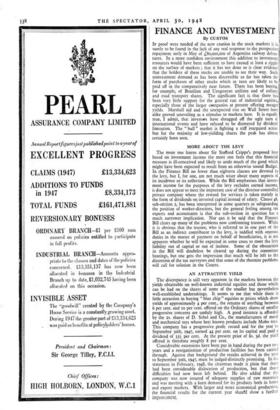FINANCE AND INVESTMENT
By CUSTOS
IF proof were needed of the new caution in the stock markets it is surely to be found in the lack of any real response to the prospective repayment early in May of k8o,000,000 of Argentine railway deben- tures. In a more confident environment this addition to investment resources would have been sufficient to have caused at least a ripple on the surface of markers; that it has not done so is clear evidence that the holders of these stocks are unable to see their way. Such reinvestment demand as has been discernible so far has taken the form of purchases of other stocks which in turn are likely to be paid off in the comparatively near future. There has been buying, for example, of Brazilian and Uruguayan utilities and of colliery and road transport shares. The significant fact is that there has been very little support for the general run of industrial equities, especially those of the larger companies at present offering meagre yields. Marshall aid and the unexpected rise on Wall Street have alike proved unavailing as a stimulus to markets here. It is equally true, I admit, that investors have shrugged off the ugly turn of international events and have refused to be dismayed by dividend limitation. The " bull " market is fighting a stiff rearguard action but for the majority of low-yielding shares the peak has almost certainly been seen.
MORE ABOUT THE LEVY
The more one learns about Sir Stafford Cripps's proposed levy based on investment income the more one feels that this financial measure is ill-conceived and likely to undo much of the good which might have been expected to result from an otherwise sound Budget. In the Finance Bill no fewer than eighteen clauses are devoted to the levy, but I, for one, am not much wiser about many aspects of its incidence or its collection. While the Bill emphasises that invest- ment income for the purposes of the levy excludes earned income, it does not appear to meet the important case of the director-controlled private company where the reward for services is taken mainly in the form of dividends on invested capital instead of salary. Clause 48, sub-settion 2, has been interpreted in some quarters as safeguarding the position of worker-directors, but the general feeling among tax experts and accountants is that the sub-section in question has a much narrower implication. Nor can it be said that the Finance Bill clears up many 'of the problems now confronting trustees. While it is obvious that the trustee, who is referred to in one part of the Bill as an indirect contributor to the levy, is saddled with onerous , duties in the matter of payment on behalf of beneficiaries, it is not apparent whether he will be expected in some cases to meet the levy liability out of capital or out of inctune. Some of the obscurities in the Bill will doubtless be cleared up during the committee hearings, but one gets the impression that much will be left to the discretion of the tax surveyors and that some of the thornier problems will call for solution in the Courts.
AN ATTRACTIVE YIELD
The discrepancy is still very apparent in the markets between the yields obtainable on well-known industrial equities and those which can be had on the shares of some of the smaller but nevertheless well-established undertakings. It seems to me that while there is little attraction in buying "blue chip" equities at prices which show yields of approximately 4 per cent., the returns of anything between 6 per cent, and to per cent, offered on the Ordinary shares of smaller progressive concerns are unduly high. A good instance is afforded by the 2s. shares of D. Sebel and Co., the manufacturers of metal and mechanical toys whose best known products include Mobo toys. This company has a progressive profit record and for the year to September 30th, 1947, earned 44 per cent. on its capital and paid a dividend of 33+ per cent. At the present price of 8s. 3d. the yield offered is therefore roughly 8 per cent.
Considerable extensions have been put in hand during the past two years and a reorganisation of production facilities has been carried through. Against that background the results achieved in the year to September 30th, 1947, must be judged distinctly promising. In his statement in February, 1948, the chairman made it plain that there had been considerable dislocation of production, but that those difficulties had now been left behind. He also added that the company was now assured of adequate supplies of raw materials and was meeting with a keen demand for its products both in home and export markets. With larger and more economical production, the financial results for the current year shoutd show a further
improvement.






























 Previous page
Previous page